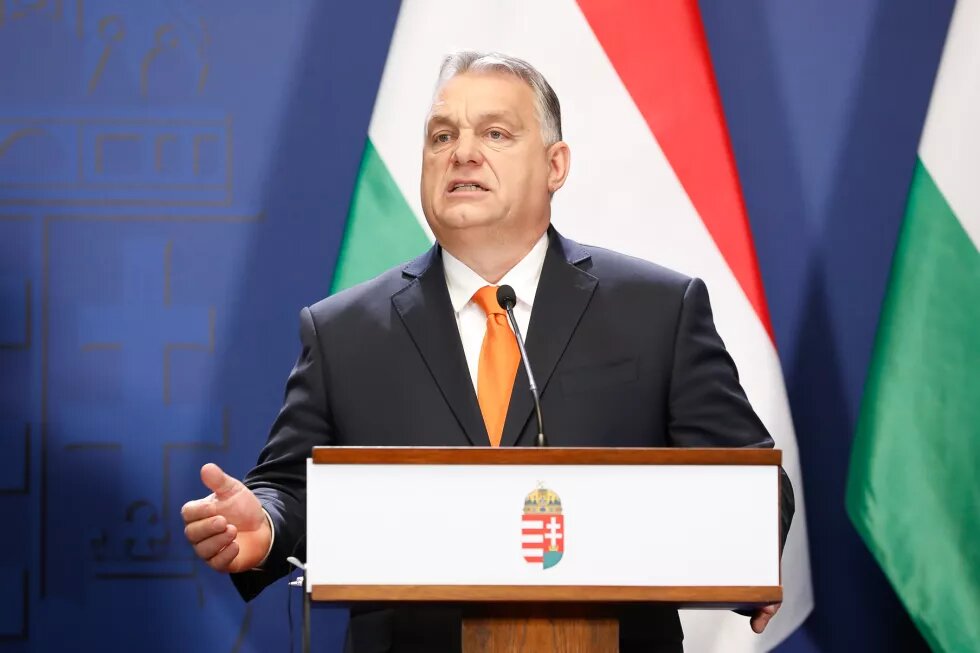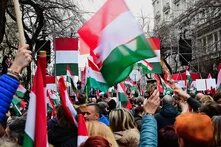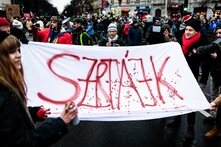Viktor Orbán’s recent thoughts on race theory in Băile Tușnad/Tusnádfürdő in Romania on 23 July have provoked strong reactions in Hungary and internationally. However, the Prime Minister has not said anything new. It was not the first time he crossed that particular “red line”. Ideas and slogans borrowed from the far right, and deliberately ambiguous language, have long been elements of Orbán’s rhetoric and a cornerstone of Fidesz’s political strategy and ideology.

"Lebensraum", "ethnic homogeneity", "mixed-race world"
Commenting on Orbán’s speech in Băile Tușnad/Tusnádfürdő this year, the Polish daily Gazeta Wyborcza wrote that the Hungarian prime minister “has not yet used the term ‘Lebensraum’, but he has come close”. The paper failed to notice that Viktor Orbán had already used the term 20 years ago, during his first prime ministership. At the time, he spoke about the “Hungarian economic living space” on the radio programme Vasárnapi Újság, which was notorious for its far-right tone. Later, in Parliament, he responded to the criticism he had received for this by saying that the term ‘living space’ was not a product of the 1930s but an earlier period and that he had used the word in an economic sense only.
The rhetoric of Orbán has then, year after year, increasingly sought to blur the boundary between the right and the far right. This was dictated by a political strategy aimed at dominating the right as a whole. This process really came to fruition in 2015, when the political exploitation of the refugee crisis pushed Fidesz to the far right, and it essentially swapped places with the far-right Jobbik, which was moving to the centre of the political spectrum. From then on, Orbán’s narrative has been based on a security framing of migration, a vision of a clash of civilisations, ethnicities, religions and cultures, and a world explanation based on conspiracy theories. It aims to polarise society by increasing hostility and fear, organising it into political tribes and getting the alarmists to support Fidesz.
Although the prime minister has often used strong language after 2015, he was only forced to similarly explain himself in 2017, when he said at the opening of the economic year of the Hungarian Chamber of Commerce and Industry that “Hungary’s ethnic homogeneity must be preserved”. This was, of course, seen by many as racism, and government crisis communication began a manoeuvre eerily similar to the current one. First, the part about ethnic homogeneity was omitted from the transcript of Viktor Orbán’s speech, then it was pretended to be a coincidence, and finally, it was argued, as it is now, that the prime minister was actually talking about preserving ‘cultural homogeneity’. Hence, according to the explanation, five years ago, the PM used the word ‘ethnic homogeneity’ in the cultural sense, and now he used the term ‘race’ in the same way.
It is worth putting the two quotes side by side.
In 2017, Viktor Orbán said: “First of all, I find it very important that we should preserve our ethnic homogeneity. Nowadays, one can say such a thing, though a few years ago, one would have been executed for such a turn of phrase. But now, one can say things like that because life has confirmed that too much mixing causes trouble. We Hungarians are naturally heterogeneous in the sense that we are a European nation. If we just started reading the names of those present here today, they would reveal all sorts of nationalities: from Bunjevci to Swabian. But in ethnic terms, these fall within certain limits, and so there is still a certain ethnic homogeneity. We are from a single civilisation. Preserving this is a key issue.”
And the often-quoted passage from this year’s Tusnadfürdő speech reads: “There is a world in which European peoples are mixed together with those arriving from outside Europe. Now that is a mixed-race world. And there is our world, where people from within Europe mix with one another, move around, work, and relocate. So, for example, in the Carpathian Basin, we are not mixed-race: we are simply a mixture of peoples living in our own European homeland. And, given a favourable alignment of stars and a following wind, these peoples merge together in a kind of Hungaro-Pannonian sauce, creating their own new European culture. This is why we have always fought: we are willing to mix with one another, but we do not want to become peoples of mixed-race”.
It is clear that we are talking about the same idea five years apart and not a one-off mistake or misuse of words. Viktor Orbán calls mixing people of the same racial group acceptable but sees mixing people of different races as dangerous for European civilisation. This year, this idea has made more waves than in 2017 because of the use of the word “race”, but there is no difference in content.
Nor is there any question of the Prime Minister taking a cultural approach as opposed to a biological approach, as he claimed in Vienna, in line with the crisis communication. Indeed, this excuse is contradicted by a third Orbán speech, the 2017 Tusnadfürdő speech. In it, the prime minister clearly equated ethnic composition with cultural identity: “There is no cultural identity without a stable ethnic composition. To change the ethnic composition of a country is to change its cultural identity. A strong country can never afford such a thing, especially if it is not forced to do so by a world disaster.” - he said, and it makes no difference whether he thinks so himself. The point is that Viktor Orbán, as a leading politician, consistently uses ideas, words and theories that have been taken over from the far right, making them widely accepted. And in cases where this has already provoked politically risky criticism at home or abroad, there is the routine explanation that the Prime Minister did not use these concepts in the same sense as the far right or that he simply expressed them in an ambiguous way. However, most people will only be able to read the original speech and the primary news reports on it, with subsequent clarifications reaching the ears of a much narrower audience.
“Grand remplacement”
As can be seen from the quoted speeches, Orbán’s ideology is no longer simply based on xenophobia, nationalism or ethnicism but a more comprehensive worldview. In a study published by Political Capital in 2020, we detailed how the conspiracy theory known as the “grand remplacement”, originated from France, has, in line with international trends on the far right, strongly influenced the narrative of Fidesz and the domestic right-wing extremist organisations, which are intertwined with the governing party at the level of individuals as well. According to this theory, well-organised external ‘immigration’ (e.g. Muslim immigrants) and internal enemies (e.g. liberals, gays) threaten the dwindling white European ‘race’ and civilisation based on traditional values. The internationalisation of far-right ideology is, therefore, one of the reasons why, in addition to ethnic origin (“I am Hungarian”), the question of culture and identity (“I am Christian-European”) and race (“I am white”) is increasingly at the centre of politics in this area.
For Viktor Orbán, this idea is so important that he even included it in his inaugural speech after the 2022 elections. According to a summary in the Hungarian weekly HVG, this was not the first time: the prime minister accused NGOs in April 2017 on the state radio channel Kossuth of “imagining a Europe in which there is a partial exchange of population, in which foreign elements from other parts of the world are allowed in”. A few months later, he also named the NGOs’ aim, saying that they were pushing for population exchanges so that “speculators like Soros could make a lot of money” - though how they could make a lot of money, he never explained. “Fewer and fewer Europeans are being born, and more and more foreigners are being brought in. This will change our culture, and after a year or two, we will not recognise our own village, our own town, our own country and our own continent,” he accused European politicians who he said supported migration, a year later. He also used the word “population change” at the 2019 Budapest Demographic Forum.
So, contrary to the interpretation of some articles, it is not just that the Prime Minister refers to a “mixed-race world” because he or his careless writers are inspired ad hoc by certain authors (such as George Friedman or Jean Raspail) before a speech, but that these views have become an integral part of Fidesz’s ideology over the past few years.
The theorists of the governing party have been strongly influenced not only by certain anti-liberal traditions in Hungarian intellectual history but also by international modernist, liberal and fascist trends. Thus, for example, some of the ideas of Oswald Spengler, Carl Schmitt, René Guénon, Alexandre Dugin, Julius Evola or Renaud Camus, who is referred to as the father of “grand remplacement” theory, can undoubtedly be found - even if often distorted - in the texts of Viktor Orbán and people revolving around Fidesz. Not to mention the manifestations and Telegram accounts of pro-Fidesz propagandists and influencers who partly overlap with far-right organisations.
Among Hungarian ideologues, Gyula Tellér is worth highlighting, who had a significant influence on Orbán’s 2014 speech in Tusnadfürdő announcing the construction of an illiberal state. According to Tellér, the Orbán system was based on communalism, a nation defined as a “historically evolved organisation of people defined by origin and culture”, as opposed to what he called the “(neo)liberal doctrine” of social organisation, in which society was a loose collection of individuals bound together by the market and a value-neutral constitution.
“One camp, one flag”
Orbán’s ideology is, of course, closely linked to his political strategy, both at home and internationally.
At the domestic level, since the proclamation of the “one camp, one flag” slogan, the central element of Fidesz’s strategy is that it cannot leave room on the right unchecked, and must control both the actors and the discourse, including the far right. The political strategy based on the idea of the ‘central power field’ after 2010 added to this by stating that Fidesz, to secure its position and image, needs the presence of a far-right party that is unable to cooperate with the left but cannot be allowed to grow too large. This was Jobbik until around 2016, and after its move to the centre and its disintegration, it is now Mi Hazánk (Our Homeland) that fills this space and which has perhaps the greatest potential to grow in today’s difficult economic and social situation. Fidesz is an active player and shaper of the far right, both in terms of actors and messages. It adopts the themes and ideas of the far right so that it can, if necessary, catch the wind from their sails. And the recent speech in Tusnadfürdő can certainly be interpreted in this party-political framework since Orbán must now also ensure that Mi Hazánk does not become a middle-sized party.
Fidesz’s strategy concerning the far right has been a dominant one at the international level in recent years. Fidesz, which had drifted away from the European People’s Party, has now built increasingly close ties with the authoritarian right and far-right (Le Pen, Salvini, etc.), which has modernised and rebranded itself as ‘sovereigntist’. These are, not least, the same actors whom Vladimir Putin, interested in weakening the European Union, is keen to support. These parties, in line with the ideology described, do not simply claim to defend national identity but to defend ethnic or cultural homogeneity or the rejection of ‘racial’ mixing, which in most cases means opposing immigration. Under this guise, they want to dismantle the rule of law and the democratic societies that emerged after the Second World War - albeit without the use of force. And instead of proclaiming world domination, they envision an individually inward-looking, ‘sovereigntist’ world coalition, in Anne Applebaum’s phrase, a ‘nationalist international’. But let’s not be naive: a world order based solely on personal/national selfishness and self-interest is the fast track to destruction. Think of Russian aggression against Ukraine or the global and local threats posed by the climate crisis.
The Hungarian version of this article was originally published by Political Capital.


